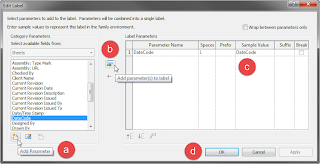The image above shows the Coded Date Parameter graph with the custom nodes replaced with the underlying nodes. This works, but it occurred to me that I might want to reuse the conversion of an integer to a two-character, zero-padded string part in the future, By creating a custom node for that part of the graph, I can save the custom node (as a DYF file) to my Dynamo definitions folder, where it will be available in the left-sash Library. An added benefit is the simplification of the main graph.
Creating a Custom Node
- Select the nodes to be included in the custom node. Multiple nodes can be selected by holding down the SHIFT key as you select individual nodes or by clicking in an empty space in the graph and, while holding the left mouse button down, dragging to enclose the nodes within a window. Like AutoCAD, if your second drag point is to the right of the first, you will have a window selection that only selects nodes completely within the window; if your second drag point is to the left of the first, you will have a crossing window that will select nodes that are either completely or partially within the window.
- Select Edit > Create Node From Selection or press CTRL+D.
- In the Custom Node Properties dialog, enter a Name and a Description (tooltip) for your custom node. Then specify a Category, which determines where the node will appear in the Library. NOTE: You do not have to select from the existing categories; you can type in a category of your choosing. Use a period to separate the name of an upper level category from the name of a nested category. In the example shown, I created a new top level category for my own nodes called "DWK" (my initials) and a subcategory called "String" below that. Press OK to create the custom node.
- Observe that the selected nodes have been replaced by a custom node, and that a new tab has appeared in the workspace.
- Select the Integer to String - 2 Char Zero Padding tab to make it current, and then, in the upper right corner of the graph pane, select the top icon (dashed line square) to zoom to the extents of the graph. Notice that Dynamo added Input and Output nodes to the custom node graph, one Input for each "wire" leading into the selected nodes and one Output for each "wire" leading out of the selected nodes. These represent the inputs and outputs of the custom node. You can rename the labels (object and result in this example in the image above) that appear on the custom node by selecting the label and typing the desired name. I chose to rename the input label to integer and the output node to string.
- Assuming that your original graph worked, the custom node is now complete. All that remains is to save the node to a DYF file, in your Dynamo definitions folder. Select File > Save from the pull-down menus or press CTRL+S to save the file. The Save As dialog should default to the appropriate folder (in my case, C:\Users\dkoch\AppData\Roaming\Dynamo\0.7\definitions; substitute your user name and Dynamo version). Failure to save the file will likely result in an undefined node in the DYN file from which you created the custom node. If you try to close the custom node tab without saving, you will be alerted to the fact that there are unsaved changes.
- A String.Length node (Core > String > Actions > Length) determines the number of characters in the string. A Number node (Core > Input > Number), set to 1.000, is compared to the string length by a != [Not Equal] node (Operators > !=), which will return true if the string length is anything but 1 and false if the string length is one.
- A String.Concat node (Core > String > Actions > Concat) concatenates the outputs of a String node (Core > Input > String), set to "0", and the output of the ToString node. This creates the potential zero-padded condition.
- An If node (Core > Logic > If) also receives the output of the ToString node, in its true input. The If node is used to determine what string will become the output of the custom node. If the result of the != node, which is fed to the test input of the If node, is true (string is not one character in length), then the original string from the ToString node is passed through as the result, since it is the input for the true input of the If node. If the original string is one character in length, then false will be passed to the test input of the If node, and the results of the String.Concat node, which is passes to the false input of the If node, will be passed through.
After getting this to work, it occurred to me that it would be more useful to have a custom node that could handle zero-padding to any specified number of characters. But since this node satisfied the needs of the immediate task, I chose to save creating such a custom node as a future task.













































